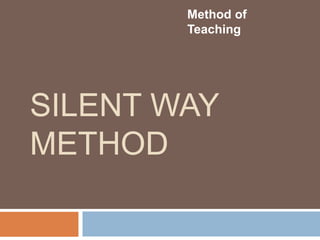
Silent way method
- 2. Introduction The Silent Way is a language-teaching method created by Caleb Gattegno that makes extensive use of silence as a teaching technique. It is not usually considered a mainstream method in language education. It was first introduced in Gattegno's book Teaching Foreign Languages in Schools: The Silent Way in 1963. Gattegno was skeptical of the mainstream language education of the time, and conceived of the method as a special case of his general theories of education The teacher uses silence for multiple purposes in the Silent Way. It is used to focus students' attention, to elicit student responses, and to encourage them to correct their own errors. Even though teachers are often silent, they are still active; they will commonly use techniques such as mouthing words and using hand gestures to help the students with their pronunciation. Teachers will also encourage students to help their peers
- 3. Advantage s Learning through problem solving looks attractive especially because it fosters: creativity, discovery, increase in intelligent potency and long term memory. The indirect role of the teacher highlights the importance and the centrality of the learner who is responsible in figuring out and testing the hypotheses about how language works. In other words teaching is subordinated to learning
- 4. Disadvantag es The Silent Way is often criticized of being a harsh method. The learner works in isolation and communication is lacking badly in a Silent Way classroom. With minimum help on the part of the teacher, the Silent Way method may put the learning itself at stake. The material ( the rods and the charts) used in this method will certainly fail to introduce all aspects of language. Other materials will have to be introduced.
- 5. Teacher roles The teacher is a technician or an engineer who facilitates learning The teacher’s role is one of neutral observer neither praise nor criticize, merely looks for continued improvement. The teacher is silent, the teachers presence in the classroom is limited to providing a model of the language, that the students are going to work on. To teach : The presentation of an item once, typically using nonverbal clues to get across meaning. To test : elicitation and saving of student production is down. In as silent a way as possible. To get out of the way : the teacher silently monitors learners’ interactions with each other and may even leave the room while learners struggle with their new linguistic tools.
- 6. Learners are expect to develop independence autonomy and responsibility. The autonomous learner chooses proper expression in a given set of circumstances and situations. The absence of corrections and repeated modeling from the teacher requires the student to develop “inner criteria” and to correct themselves. Learners have only themselves as individuals and the group to rely on, and so must learn to work cooperatively rather than competitively. Learner also must be a teacher, a student, part of support system, a problem solver, and a self-evaluator.
- 7. The materials are used to illustrate the relationships between sound meaning in the target language. The materials are designed for manipulation by the students and the teacher, independently and cooperatively, in promoting learning by direct association. The number of languages and contain symbols in the target language for all of the vowel and consonant sounds of the language. The symbols are color coded according to pronunciation ; thus, if a language possesses to different symbols for the same sound, they will be colored alike. One of examples The role of instructional materials
- 8. CLOSING WORDS Tell me and I forget Teach me and I remember Involve me and I learn Benjamin Franklin
